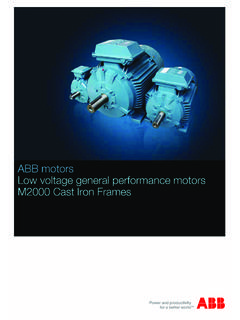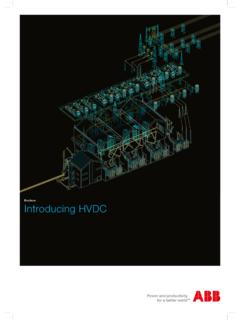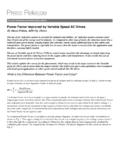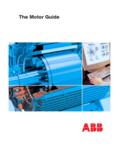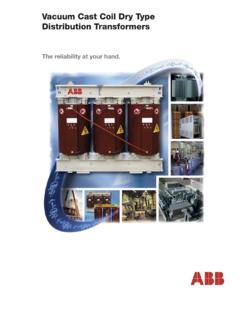Transcription of Working with the Trip Characteristic Curves of ABB SACE ...
1 Working with the Trip Characteristic Curves of ABB SACE Low voltage Circuit-Breakers1 SDC007400G0201 Working with the Trip Characteristic Curves of ABB SACE Low voltage Circuit Breakers1 ABB SACEI ndex1. Introduction ..22. Main Definitions ..33. ABB SACE Low voltage Circuit Breakers complying with the Standards UL 489 and UL 1066 Generalities on Low voltage Circuit Breakers ..7 ABB SACE Low voltage Circuit Breakers ..8 Molded-Case Circuit Breakers (Tmax) ..8 Low voltage Power Circuit Breakers (Emax) ..104. Thermomagnetic and Electronic Trip Units for ABB SACE Circuit Breakers Thermomagnetic Trip Units ..12 Overload Protection (L) ..12 Instantaneous Short Circuit Protection (I) ..12 Thermomagnetic Trip Units for Tmax Circuit Breakers ..13 Time-Current Curve of a Thermomagnetic Trip Unit TMA.
2 14 Setting Examples of a Trip Unit TMA ..15 Electronic Trip Units ..16 Overload Protection (L) ..16 Short-Circuit Protection with Delayed Trip (S) ..17 Instantaneous Short-Circuit Protection (I) ..19 Ground-Fault Protection (G) ..20 Electronic Trip Units for Tmax Circuit Breakers ..21 Setting Examples of a Trip Unit PR222DS ..22 Electronic Trip Units for Emax Circuit Breakers ..245. Trip Curves of ABB SACE Trip Units Trip Curves of Thermomagnetic Trip Units ..25 Trip Curves of Electronic Trip Units ..26 Functions L and S ..26 Function I ..29 Function G ..306. Curves of Current Limiting Circuit Breakers: Let-Through Values of I2t and Peak Current ..32 Annex A: Tolerance in the Trip Curves .
3 35 Glossary .. 362 Working with the Trip Characteristic Curves of ABB SACE Low voltage Circuit BreakersABB SACE1. IntroductionThis White Paper is aimed at making easier the reading and the interpretation of the Characteristic Curves (trip Curves , specific let-through energy Curves and limitation Curves ) of the Molded-Case Circuit Breakers (MCCBs) and Low Volt-age Power Circuit Breakers (LVPCBs) manufactured by ABB SACE in compliance with the following American Standards:- UL 489: Molded-Case Circuit Breakers, Molded-Case Switches and Circuit Breaker Enclosures- UL 1066: Low- voltage AC and DC Power Circuit Breakers Used in Enclosures- ANSI : IEEE Standard for Low- voltage AC Power Circuit Breakers Used in Enclosures- ANSI : Low- voltage Power Circuit Breakers and AC Power Circuit Protec-tors.
4 Preferred Ratings, Related Requirements, and Application Recommenda-tions- ANSI : American National Standard for Trip Devices for AC and General Purpose DC Low voltage Power Circuit BreakersThis publication is mainly divided into four first introductory part (Chapters 1 and 2) describes the purposes of this White Paper and reports all the definitions useful for its second part (Chapter 3) offers a scenario of ABB SACE industrial circuit breakers manufactured in compliance with the requirements of the UL Standards. The third part (Chapter 4) describes the trip units of ABB SACE circuit breakers and the associated Characteristic trip , the fourth and last part (Chapters 5 and 6) reports some reading exam-ples of Curves to help the reader in the comprehension and interpretation of the information they Introduction2 ABB SACE3 Working with the Trip Characteristic Curves of ABB SACE Low voltage Circuit BreakersABB SACE2.
5 Main DefinitionsHereunder are the main definitions extracted from the Standards UL 489, UL 1066, ANSI and ANSI , useful to better understand the contents of this from the Standard UL 489 1 - ADJUSTABLE CIRCUIT BREAKER: a circuit breaker that has adjustable time/current tripping characteristics. These may include: a) Inverse-time (such as continuous current, long time, and/or short time); b) Instantaneous; c) Ground-fault. 2 - ADJUSTABLE INSTANTANEOUS RELEASE (TRIP): that part of an overcur-rent trip element that can be adjusted to trip a circuit breaker instantaneous-ly at various values of current within a predetermined range of currents. 3 - CIRCUIT BREAKER: a device designed to open and close a circuit by non-automatic means, and to open the circuit automatically on a predetermined overcurrent, without damage to itself when properly applied within its rat-ing.
6 4 - CIRCUIT BREAKERS WITH GROUND-FAULT PROTECTION FOR EQUIP-MENT: circuit breakers that perform all normal circuit breaker functions and also trip when a fault current to ground exceeds a predetermined value. 5 - CURRENT-LIMITING CIRCUIT BREAKER: one that does not employ a fusi-ble element and, when operating within its current-limiting range, limits the let-through I2t (see definition 20 AMPERES SQUARED SECONDS) to a value less than the I2t of a 1/2-cycle wave of the symmetrical prospective currentLimited short-circuit currentIkt Underwriters Laboratories2. Main Definitions4 Working with the Trip Characteristic Curves of ABB SACE Low voltage Circuit BreakersABB SACE 6 - CURRENT-LIMITING RANGE: the RMS symmetrical prospective currents between the threshold current and the maximum interrupting rating current.
7 7 - CURRENT SETTING (lr): the RMS current an adjustable circuit breaker is set to carry continuously without tripping. It is normally expressed as a percent-age of the rated current and is adjustable. 8 - FIXED INSTANTANEOUS RELEASE (TRIP): that part of an overcurrent re-lease element which contains a nonadjustable means that is set to trip a circuit breaker instantaneously above a predetermined value of current. 9 - FRAME: an assembly consisting of all parts of a circuit breaker except an interchangeable trip unit. 10 - FRAME SIZE: a term applied to a group of circuit breakers of similar physi-cal configuration. Frame size is expressed in amperes and corresponds to the largest ampere rating available in the group. The same frame size desig-nation may be applied to more than one group of circuit breakers.
8 11 - GROUND-FAULT DELAY: an intentional time delay in the tripping function of a circuit breaker when a ground-fault occurs. 12 - GROUND-FAULT PICKUP SETTING: the nominal value of the ground-fault current at which the ground-fault delay function is initiated. 13 - INSTANTANEOUS OVERRIDE: a fixed current level at which an adjustable circuit breaker will override all settings and will trip instantaneously. 14 - INSTANTANEOUS PICKUP SETTING: the nominal value of current that an adjustable circuit breaker is set to trip instantaneously. 15 - INSTANTANEOUS TRIP: a qualifying term indicating that no delay is pur-posely introduced in the automatic tripping of the circuit breaker. 16 - INSTANTANEOUS TRIP CIRCUIT BREAKER (MOTOR CIRCUIT PROTEC-TOR OR CIRCUIT INTERRUPTER): is one intended to provide short circuit protection only.
9 Although acting instantaneously under short circuit condi-tions, these circuit breakers are permitted to include a transient dampening action to ride through initial motor transients. 17 - INTERCHANGEABLE TRIP UNIT: one which can be interchanged by a user among circuit breaker frames of the same design (to see also definition 32 RATING PLUG). 18 - INTERRUPTING RATING: the highest current at rated voltage that a device is intended to interrupt under standard test conditions. 19 - INVERSE TIME: a qualifying term indicating that there is a purposely intro-duced delayed tripping in which the delay decreases as the magnitude of the current increases. 20 - I2t (AMPERES SQUARED SECONDS): an expression related to the circuit en-ergy as a result of current flow. With respect to circuit breakers, the I2t [A2s] is expressed for the current flow between the initiation of the fault current and the clearing of the circuit.
10 21 - LONG-TIME DELAY: an intentional time delay in the overload tripping of an adjustable circuit breaker s inverse time characteristics. The position of the long time portion of the trip curve is normally referenced in seconds at 600 percent of the current setting (Ir). 12 - LONG-TIME PICKUP: the current at which the long-time delay function is initiated. 13 - MOLDED-CASE CIRCUIT BREAKER: a circuit breaker which is assembled as an integral unit in a supportive and enclosed housing of insulating Main Definitions5 Working with the Trip Characteristic Curves of ABB SACE Low voltage Circuit BreakersABB SACE24 - OVERCURRENT: Any current in excess of the rated current of equipment or the ampacity of a conductor. It may result from overload, short-circuit, or ground-fault. 25 - OVERLOAD: Operation of equipment in excess of normal, full-load rating or of a conductor in excess of rated ampacity that, when it persists for a suf-ficient length of time, would cause damage or dangerous - PEAK CURRENT: the maximum instantaneous current that flows in a - PROSPECTIVE CURRENT (AVAILABLE CURRENT): the current that which would flow in a circuit if a short circuit of negligible impedance were to oc-cur at a given - RATED CURRENT (In): the marked current rating and the maximum RMS current a circuit breaker can carry continuously without tripping and the maximum current the circuit breaker will carry without changing, deleting, or adding a part or parts such as trip units and rating plugs.
